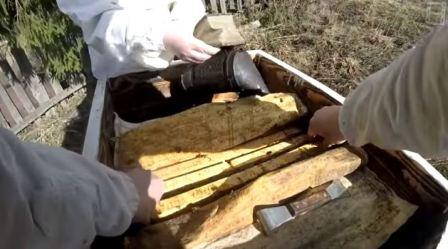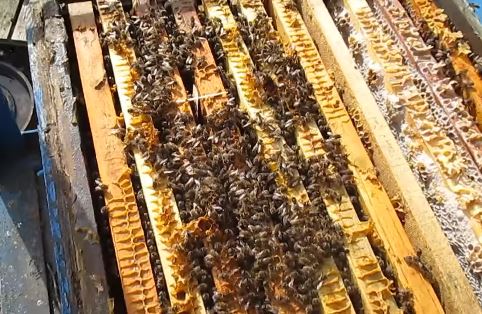How to conduct the first quick look of bees after wintering

The first quick look of bees in the spring after flying around is important for the beekeeper’s further actions. In this article we will consider such questions as when in the spring you need to do the first quick look of bees, and there will also be a lot of other information useful for beekeepers. Read to the end - it will be interesting.
Content
- When in the spring you need to do the first quick look of bees
- Preparing for the first spring quick look of bees
- How to conduct your first bee inspection
- What should a beekeeper pay attention to first of all when conducting the first spring quick look of bees?
When do the first spring quick look of bees take place?
When in the spring should you do the first quick look of bees? The beekeeper should carefully observe the first flight of bees, and record in the apiary journal or take note of all the bee colonies that flew around the worst. These bee colonies will be inspected first.
Important!
A beekeeper should not confuse a quick first spring inspection of bees after flying around with a spring inspection of the apiary.
It is impossible to postpone the first spring quick look of bees, this can lead to the death of bee colonies that have not overwintered well.
Preparing for the first spring bee inspection
The first spring inspection of bees requires preliminary preparation from the beekeeper. As soon as the mass spring flight is over, preparations begin for the first spring inspection of the bees after the flight: in all hives the entrances are reduced to 2-5 cm and then they immediately begin a cursory examination of the bee colonies. Before inspecting the bee nest, that is, before opening the hive, it is extremely important for the beekeeper to prepare accordingly both himself, as this is described in the article technique for inspecting bee colonies, and all the equipment necessary for the spring inspection of bees, which facilitates the performance of certain works, and the main thing is all the necessary materials (spare honeycombs with food, or feeders with syrup, insulation), so that the first spring inspection of the bees after flying around takes as little time as possible to prevent the nest and brood from cooling.
How to conduct your first bee inspection in spring
When conducting the first spring inspection of bee colonies, the beekeeper adheres to several simple rules.
To prevent the nest and brood from cooling, the canvas and pillow should not be completely removed from the top of the frames; the beekeeper vacates only the place from which he is currently removing the frame. To achieve a reduction in heat loss, the beekeeper must have a spare canvas to cover the already inspected frames. Clean empty frames with patches of honey do not have to be taken from the nest; they can be placed behind the follower board. The bees will subsequently take the remaining honey from these frames. In this way, the beekeeper will reduce the nest to the optimal size.
There is no need to use a lot of smoke, as a rule, on the day of the flight the bees are not very aggressive and hardly bite, on the second day the bees will be more aggressive. So we smoke a little, just for show.
What should a beekeeper pay attention to first when conducting the first spring inspection of bees?
During the first spring inspection of bees after flying around, all bee colonies are ascertained
- Condition of bee colonies after wintering,
- Is there a queen in the hive?
- Availability of food in the hive,
- The condition of the bee nest and, first of all, the condition of the hive frames.
If, during spring beehive inspection after the flight, the reason for the poor wintering of the bees is established, then the beekeeper will provide appropriate assistance to such a bee colony.

There are few photos of bees in the nest in the spring, so one tick strip is enough to prevent it from falling to the bottom of the hive; it is convenient to pierce it with a sharp stick, such as a toothpick, in this form the strip is guaranteed to work.
It is also important to take one more action at this time. Since the winter cluster has already disintegrated completely, it is necessary to install tick strips. This is especially important in the southern regions, where mild winters reduce the period when the bee colony does not hatch brood. If this is not done, then the tick will develop like an avalanche and at the beginning of summer the number of ticks in families will be very high.
.
- How to provide assistance to bee colonies that have wintered unfavorably.
- How to strengthen a weak bee colony in spring
- How to help motherless families
Carrying out the first spring inspection of bee colonies after flying around, the beekeeper determines the general condition of the bee colonies after wintering, establishing
- Is there dampness in the hive?
- Number of bees dying
- Are the honeycombs stained with diarrhea stains?
- Whether the honeycombs are damaged by mice or not.
The strength of a bee colony is determined by the number of frames occupied by bees. The presence of a queen is determined by the eggs present in the cells of the honeycomb, on frames with brood; there is no need to look for the queen itself in the hive. The amount of food in the hive is determined by first inspecting the outer frames, and if there is no honey on them, then while inspecting the other frames of the nest, you need to carefully scrape off the wax cappings of honey with a chisel to find out whether the honey has crystallized in the cells.
At the same time, check the presence of beebread in the hive; if there is a deficiency, it is necessary to give the bees protein food
.
- Protein spring feeding for bees cooking recipes
- Kandy with soy flour recipes for feeding bees
- How to make whey syrup for bees
When conducting the first spring beehive inspection, empty, worn-out frames, as well as frames with traces of mold, are removed from the nest. Heavily dirty bottoms and hive bodies are replaced with clean ones. If necessary, the bees are replenished with food supplies in the hive. Honey feather frames, prepared from last season and placed in the hive to replenish food, are usually placed by the coverts; it is also permissible to place a warm honey feather frame right next to the brood.
Important!
Some beekeepers, in order to replenish the food reserves of the bees when inspecting the bees for the first time in the spring, use a frame with honey and place it flat on top of the nest. This is a completely acceptable way to replenish bees’ food supplies, but there is one peculiarity. Some beekeepers, in order to replenish the bees' food reserves in this way, preheat the frame with honey indoors or in another way. This is absolutely not worth doing. The fact is that if you put a warm frame on top of the nest, the bees and the queen will rise up from the frame because they will feel the warmth. and this is not very good if the first flyby begins in February and there is still cold weather ahead.
It is better to place a cold frame flat on top of the nest, in this case it will heat up from the bees, since the heat from them goes up and gradually the bees will reach this frame and will feed on this honey
.
After the first spring inspection of bees is completed, the colony should be insulated.
